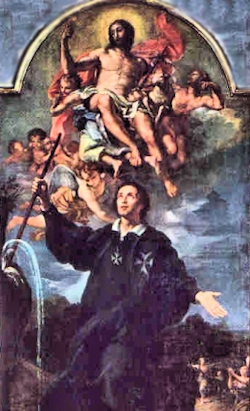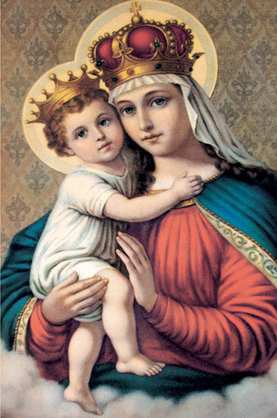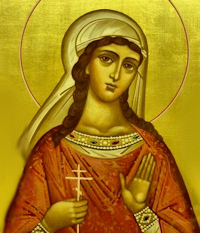Ordinary Time: October 8th
Tuesday of the Twenty-Seventh Week of Ordinary Time
Other Commemorations: Our Lady of Good Remedy (Hist); St. Pelagia, Hermit (RM); St. Hugo of Canefro, Religious (RM)
» Enjoy our Liturgical Seasons series of e-books!
According to the 1962 Missal of St. John XXIII the Extraordinary Form of the Roman Rite, today is the feast of St. Bridget of Sweden, widow.
It is also the feast of Sts. Sergius, Bacchus, Marcellus and Apuleius, Roman martyrs. In the Ordinary Form of the Roman Rite, these martyrs, plus many others, are honored on June 30 and St. Bridget is celebrated on July 23.
Historically today is the feast of St. Demetrius of Sirmium who was both soldier and martyr; he suffered in the early 4th century under Maximian. He became immensely popular in the East, where he was called ‘The Great Martyr,’ and subsequently in the West.
St. Pelagia (Latin form Marina)
St. Pelagia lived in the 4th or 5th century, and was originally known as "Margarita." She was head of a dance troupe in Palestinian Antioch and lived a life of frivolity and prostitution. One day while she was still a dancer, Margarita was passing by a church dressed in her very elegant and provocative clothing. Bishop Nonnus of Edessa was preaching at that moment. Even though the parishioners turned their faces away from the sinner, the Bishop noticed her great outer beauty and spiritual greatness. Later that day, he prayed in his cell for the sinner and learned that as she took care of the adornment of her body to appear beautiful, he and his fellow priests should put more work into adorning their wretched souls.
The following day Pelagia went to hear St. Nonnus preach. He was talking about the Last Judgement and its consequences. She was so moved and impressed with the sermon, that with tears of repentance in her eyes, she asked the Bishop to baptize her. Seeing the sincerity of her wishes and repentance, he agreed. Nonnus took her confession and baptized "Margarita" under her birth name Pelagia.
That same night the devil appeared to Pelagia urging her to return to her former life. She started praying and signed herself with the Sign of the Cross, after which the devil vanished.
She gave all her wealth and valuables to St. Nonnus so that he could distribute them and give them to aid the poor. The bishop ordered their distribution and said: "Let this be wisely dispersed, so that these riches gained by sin may become a wealth of righteousness." She left Antioch dressed in man’s clothes.
After that, she journeyed to the Mount of Olives in Jerusalem, where she became a hermitess and lived in a cell disguised as the monk Pelagius. There she lived in great austerity, performing many penances in ascetic seclusion which helped her attain many spiritual gifts. At her death, she was buried in her cell. She was known as “the beardless monk” until her sex was discovered when she died.
—Excerpted from Catholic News Agency
Patronage: actresses
Highlights and Things To Do:
- In some accounts it is said Pelagia wore men's clothing to disguise herself as a male hermit. She is sometimes referred to as The Beardless Hermit.
- See her statue at St. Peter's Basilica Colonnade.
- There are several different accounts and at times it can be difficult to sort through who is the real St. Pelagia. Read more at:
- Pelagia's accounts are thought to come from Jacob the Deacon.
St. Hugh Canefro
 Also known as Hugh of Genoa, Hugh of Canefri, Hugo, Ugo—Religious of the Order of Malta, Apostle of Charity, Miracle-Worker—born in 1148 at Alessandria, Italy and died on October 8, 1233 in Genoa, Italy of natural causes.
Also known as Hugh of Genoa, Hugh of Canefri, Hugo, Ugo—Religious of the Order of Malta, Apostle of Charity, Miracle-Worker—born in 1148 at Alessandria, Italy and died on October 8, 1233 in Genoa, Italy of natural causes.
St. Hugh became a knight of the Order of St. John of Jerusalem (also known as the Order of Saint John, Order of Hospitallers, Knights Hospitaller, is a medieval Catholic military order. It was headquartered in the Kingdom of Jerusalem, on the island of Rhodes, in Malta, and St Petersburg.) After lengthy campaigning in the Holy Land, he was elected Master of the Commandery of St. John di Prè in Genoa (Italy) and worked in the infirmary nearby. He was renowned for miraculous powers over the natural elements.
St. Hugh is one of the most highly venerated saints of the Order. He was the Commander at Genoa and administered his Hospital in the best of fashions. That did not keep him from being an edifying, religious “exercising religion toward God and his neighbors." It is well known how much sacrifice and devotion that phrase can contain.
According to the portrait that Grandmaster Cardinal Fra Hugh de Loubenx Verdala gave the Order, an authentic portrait made while the saint was still alive, we know that the latter was thin, with an ascetic face and small in stature. But he was quite comely and amiable toward all. His mortification was not onerous for others. He slept on a board, in a corner of the basement of the Hospital, he served the poor with love and tact, giving them food, money, spiritual comfort, and brotherly love. He washed their feet. He took care of them and when they died, he buried them. The eight-pointed cross was not only on his cloak—he wore it in his heart. So great was his zeal that he girded himself with an iron belt placed next to his body. He fasted the whole year round, eating nothing which had been cooked, during Lent.
On one of those sultry Italian days, when the sun crushes nature with burning heat, some women were in the common room of the infirmary washing the linen of the sick. The water supply failed, for the fountain of the monastery had dried up.
They were dismayed, therefore, at having to fetch the water necessary for their task from a great distance. They complained among themselves discreetly—that is, with great outcries—so that the saint heard them and came to them to inquire about the cause of their complaints.
Seeing him, they begged him to give them water and, as he declined, they cried: “What? You wouldn’t be able to get any from God?” "We must pray."
“Oh! that’s all we do. Hear us."
“I am not the Lord, He said that faith makes miracles. Have you faith?” They insisted; he resisted.
They wept, saying that they would die of exhaustion because of the work and the heat. He hardly believed that but through charity, after having invoked the Master of Nature, the saint made the sign of the cross and the waters gushed from the rock of the fountain to the astonished cries of the servants.
—Excerpted from Anastpaul
Often Represented As: bringing water from a rock; changing water to wine; saving a ship in danger of sinking
Highlights and Things To Do:
- Learn more about the Order of Malta.
- Read more about St. Hugh here.
Our Lady of Good Remedy
 In 1519 Cortez brought with him a famous little statue to participate in the conquest of Mexico. The statue was first set up in a temporary chapel in one of the rooms of Montezuma’s palace where the Spanish officers made their devotions. On the terrible night when the Indians rose against the Spanish conquerors, the Night of Sorrows, one of the officers rescued the statue before fighting his way out of the palace. He did not get far when he was cut down by Aztec arrows and died at the foot of a Maguey tree. The tiny statue was either pushed or fell into the roots of the tree where it was overlooked by the Indians.
In 1519 Cortez brought with him a famous little statue to participate in the conquest of Mexico. The statue was first set up in a temporary chapel in one of the rooms of Montezuma’s palace where the Spanish officers made their devotions. On the terrible night when the Indians rose against the Spanish conquerors, the Night of Sorrows, one of the officers rescued the statue before fighting his way out of the palace. He did not get far when he was cut down by Aztec arrows and died at the foot of a Maguey tree. The tiny statue was either pushed or fell into the roots of the tree where it was overlooked by the Indians.
Some twenty years later, an Aztec convert, Prince John the Eagle, was walking near the tree when he heard a sweet voice calling him. Puzzled, he went to the nearby mission of the Franciscan Fathers and told them about it. They thought it was his imagination. Some days later John met with an accident, a large pillar of a church under construction fell on him. Badly crushed, he was given the Last Sacraments.
During the night when he was thought to be dying, the memory of the sweet voice kept returning to him. He prayed to Our Lady to help him. Very early in the morning the Virgin Mary appeared to him and gave him a sash to wear which cured him. A few days later he passed the tree again, and heard the sweet voice; curiously, he looked carefully around the roots of the tree; half buried in the sand, he found the tiny statue of Our Lady.
The Aztec convert thought he should do something about it. “Come home with me, gracious Lady,” he said, “I will see that you have a good home and are cared for.” He brought the little statue home wrapped in his cape and placed it on a rough altar.
Here Mary reigned as queen in the humble home for ten or twelve years. John kept the little shrine supplied with flowers, and occasionally with fruit and pretty stones. Gradually people came to pray at the shrine, their number increasing so that they were underfoot day and night. John took up the local schoolmaster’s suggestion to build a little chapel. He set about building a shrine and enthroned Mary, Our Lady of Good Remedies, there.
—Excerpted from Roman Catholic Saints
Highlights and Things To Do:
- Read more about Our Lady of Good Remedy:
- Find out more about St. John of Matha.
- Find out more about the Order of Trinitarians.








